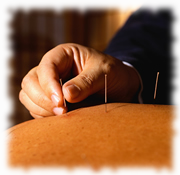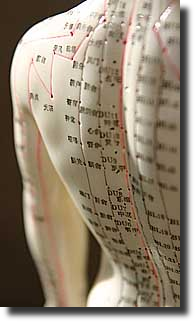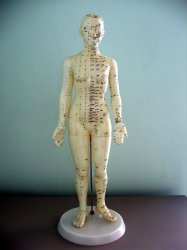Traditional Chinese Acupuncture

Acupuncture has been keeping millions of people healthy for thousands of years and here in New Zealand it is becoming recognised for general and hollistic healing.
Acupuncture is an ancient Chinese form of medicine which has been used in China for the last 3000 years. Its' effectiveness is now accepted in various countries including New Zealand, especially as more people in our society dislike taking medical drugs. Prior to the time when there were microscopes by which people could envision individual cells and before autopsies revealed the intricate structures within the body, doctors and scholars projected the internal workings of the body from what they could actually experience, which was the world outside the body. On this basis, the workings of the body were described in terms similar to those used to describe the visible world. One of the critical aspects of nature for humans living a thousand years ago, when Chinese civilization was well developed, was the system of water courses, which included tiny streams, huge rivers, man-made canals and irrigation systems, and the ocean. It was envisioned that the body had a similar system of moving, life-giving fluid. This fluid was the qi, and the pathways through which it flowed were the meridians.
How does it work?

The understanding of how acupuncture works has evolved with its practice, but the descriptions set down a thousand years ago have largely been retained. The dominant function of acupuncture is to regulate the circulation of qi (vital energy) and blood. Approximately 2,000 years ago, the pre-eminent acupuncture text, Huangdi Neijing (Yellow Emperor's Classic on Internal Medicine), was written. In it, acupuncture was described as a means of letting out excess qi or blood by making holes in the body along certain pathways, called jingluo (meridians). For some of these meridians, it was advised to acupuncture in such a way as to let out the blood but not the qi; for others, to let out the qi, but not the blood. Many diseases were thought to enter the body through the skin, and then penetrate inward through muscle, internal organs, and, if not cured in timely fashion, to the marrow of the bone. By inserting a needle to the appropriate depth-to correspond with the degree of disease penetration-the disease could be let out.
Although this description of the basic acupuncture concept is somewhat simplified, it conveys the approach that is taught today to students of traditional acupuncture: locate the areas of disturbance, isolate the main blockage points, and clear the blockage. Of course, many layers of sophistication have been added to this model, so that the needling-which might be carried out in several different ways-can be seen to have subtle and differing effects depending upon the site(s) needled, the depth and direction of needling, and even the chemical composition of the needle (such as gold, silver, or steel). For example, some needling techniques are used for the primary purpose of increasing the flow of qi in a meridian without necessarily removing any blockage; other techniques reduce the flow of qi in the meridians. These tonifying and draining methods, as well as transference methods that help move qi from one meridian to another, are part of the more general aim of balancing the flow of qi in the body.
Physiotherapists use a wide range of drug-free techniques to relieve pain, restore function and movement, and prevent further problems, including:
Does it hurt?

Some people would like to try acupuncture, but may not because they assume it will be painful. the needles is use are solid and much finer than those used for injections or withdrawing blood. In most cases only a slight prick is felt when the needle goes through the skin. When the needle reaches the acupuncture point there is another sensation felt, often described as a dull ache, heaviness or even tingling. The sensation felt is generally acceptable and lasts only one or two seconds. Your clinician will encourage continual feedback from you, letting htem know if there is any discomfort, as this can be alleviated by a small correction of the needle or by complete removal.
What can Acupuncture be used to treat?
Acupuncture is known to effectively treat a wide range of conditions - some of them are described below. (Based upon recommendations of the World Health Organisation, scientific literature and acupuncture colleges)
- Musculoskeletal
- Low back pain, tennis elbow, knee strain, neck and shoulder pain, sciatica, arthritis, joint swelling, thoracic pain, muscle strain, hip pain, and carpel tunnel syndrome.
- Respiratory
- Sinusitis, hay fever, common cold, bronchitis, asthma, cough, painful respiration, nosebleed.
- Gastrointestinal
- Constipation, irritable bowel syndrome, colitis, diarrhoea, nausea, abdominal pain, gastritis, haemarrhoids.
- Cardiovascular
- Angina, palpitations, high and low blood pressure.
- Women's health
- Painful periods, premenstrual syndrome, excessive menstrual bleeding, irregular menstruation, fertility disorders, menopausal syndrome.
- Pregnancy
- Morning sickness, foetal malposition, insufficient lactation, pregnancy tune-up, assitance with deliveries, post natal depression.
- Neurological
- Headaches, migraines, trigeminal neuralgia, shingles, Meniere's Disease, tinnitus and ear pain, Bell's palsy, hemiplegia, post-stroke syndrome.
- Metabolic disorders
- Low energy, insomnia, chronic fatigue syndrome, adrenal insufficiency, hormonal irregularities.
- Psychological disorders
- Post-traumatic stress, anxiety, smoking and drug addiction, depression, erectile disfunction.

